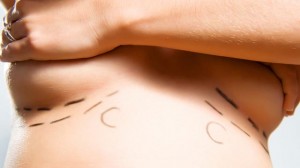Fat Transfer for Breast Enhancement
One of the most exciting developments in breast enhancement is fat transfer. In this technique, liposuction first removes some excess, unwanted fat from a desired part of the body – usually the abdomen or thighs. The removed fat is purified, and then is injected into the patient’s breasts. Fat transfer can be used either as a stand-alone breast augmentation procedure, or as a way to enhance the results of breast reconstruction. There are many reasons why fat transfer can be a successful option for many women if performed in the appropriate setting, but as a board certified plastic surgeon, I also want to caution patients about a few misconceptions about the procedure.
 Advantage: Fat transfer is a very simple way to enhance the breasts. The injections can be done using local anesthetic, so this procedure is minimally-invasive and carries less risk of an infection, simply because it minimizes the incisions that would otherwise be larger if implants were used to increase the breast size.
Advantage: Fat transfer is a very simple way to enhance the breasts. The injections can be done using local anesthetic, so this procedure is minimally-invasive and carries less risk of an infection, simply because it minimizes the incisions that would otherwise be larger if implants were used to increase the breast size.
Advantage: Fat transfer may provide smoother, natural-looking results. Because the added tissue is soft and free-moving, rather than inside a flexible yet round shape, it seamlessly adds volume to create an especially natural-looking result.
However, fat transfer provides a more mild augmentation than implants do. While fat transfer patients, like breast implant patients, can choose how significant they would like their size change to be, fat transfer simply has a more limited augmentation potential than implants do. In addition, it isn’t possible to know how much of the injected fat will ultimately survive and how much will be reabsorbed, so there may be a higher risk of breast asymmetry. Fat transfer is ideal for women who are looking for a natural, subtle breast enhancement, while implants are typically preferable for women who are seeking a more substantial size increase.
Advantage: Fat transfer combines two cosmetic enhancements in one: removing excess fat and adding breast volume. By using the patient’s own fat to augment her breasts, the fat transfer procedure serves two cosmetic purposes at once. For many women, combining the procedures can diminish the total recovery time, compared to having two separate procedures for liposuction and breast augmentation using implants.
However, this procedure should not be used for quick weight loss. Some patients who are in the process of losing weight feel that this procedure would be a good way to kick-start their results. But in order to provide the best possible plastic surgery results, I encourage patients to reach a stable weight before undergoing any plastic surgery procedure. Fat transfer is more ideal for patients who have reached a healthy, stable weight, but have stubborn pockets of fat that are not responding to healthy diet and exercise.
The fat transfer technique can be a great way for breast augmentation and breast reconstruction patients to have more natural-looking, safer results. But just as with any cosmetic procedure, patients need to be cautious about who they allow to perform the procedure, and about having realistic and accurate expectations for their results. Fortunately, both of these concerns can be resolved simply by doing your research. To start the process toward being more comfortable with your appearance, contact me, Dr. Franklyn Elliott, to schedule a consultation and join me on Facebook, Twitter, or Google+ for daily updates about the procedures I offer.
